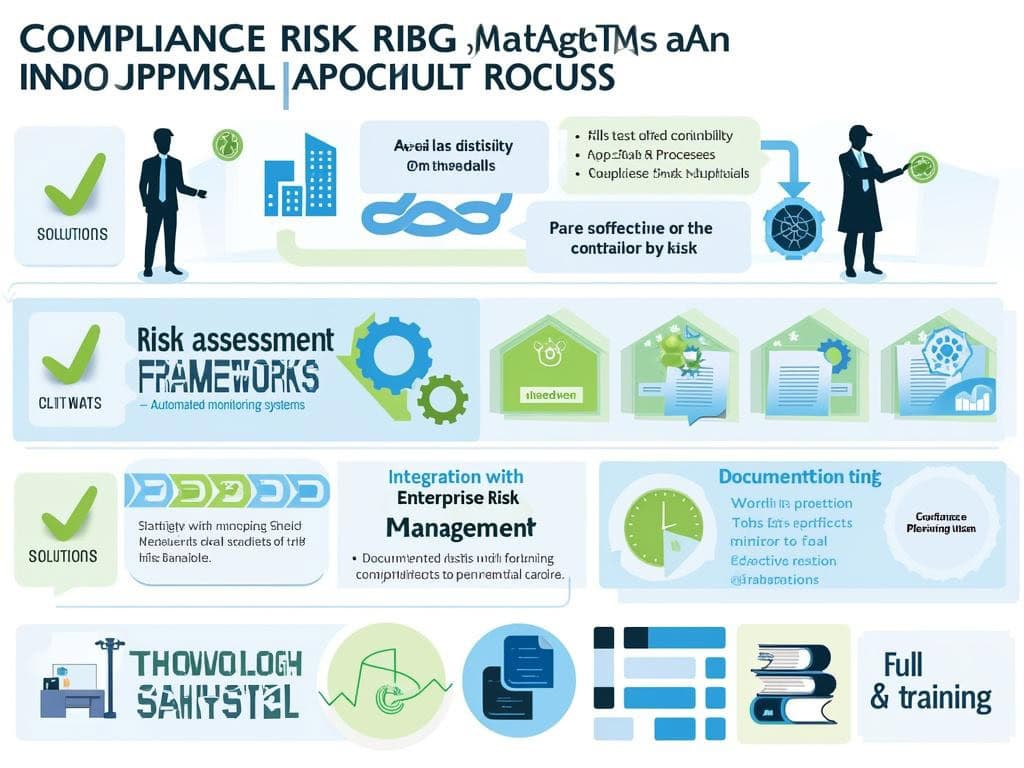
Structured Approach to Compliance Risk Management in Appraisals
Creating a structured approach to identifying and managing compliance risks is vital for maintaining regulatory adherence in appraisal processes. Effective regulatory compliance and risk management requires a comprehensive framework that protects organizations from potential penalties and reputational damage while ensuring consistent, transparent appraisal practices.
Key Takeaways
- Establish strong risk assessment frameworks that cover federal guidelines and regulatory requirements
- Implement automated monitoring systems for continuous compliance verification
- Maintain clear documentation processes that satisfy legal obligations
- Integrate compliance activities with broader enterprise risk management strategies
- Leverage technology solutions to reduce manual compliance burdens and improve accuracy
Risk assessment frameworks should align with industry standards and professional appraisal standards to identify potential compliance gaps. Your organization benefits from systematic evaluation of regulatory requirements against current practices, highlighting areas that need immediate attention.
Automated monitoring systems offer real-time oversight of appraisal activities. These systems can track appraisal timelines, flag inconsistencies, and generate alerts for potential compliance issues before they escalate into serious problems.
Documentation serves as your defense against regulatory scrutiny. Clear, consistent record-keeping practices demonstrate good faith efforts to comply with applicable laws. This includes maintaining detailed logs of appraiser qualifications, methodology decisions, and quality control measures.
Compliance can’t exist in isolation from your broader risk management strategy. By integrating appraisal compliance into enterprise risk frameworks, you create a unified approach to identifying, assessing, and mitigating various operational risks.
Technology plays a crucial role in modern compliance management. Advanced appraisal compliance solutions help standardize workflows, enforce regulatory requirements, and provide audit trails that satisfy examiner expectations while reducing manual effort.
Staff training remains essential for effective compliance. Regular education on regulatory changes, ethical considerations, and appropriate valuation methodologies builds a culture of compliance throughout your organization.
Risk-based testing protocols help identify compliance vulnerabilities. Periodic sampling and testing of completed appraisals against regulatory requirements provides assurance that your processes meet applicable standards.
Third-party oversight requires specific attention when outsourcing appraisal functions. Establish clear vendor management protocols that verify compliance capabilities, monitor performance, and ensure accountability for regulatory adherence.
Data security considerations intersect with appraisal compliance requirements. Implement appropriate security protocols for handling sensitive property and borrower information throughout the appraisal process.
Compliance metrics provide objective measurement of your program’s effectiveness. Track key indicators such as regulatory exceptions, turnaround times, and quality control findings to demonstrate continuous improvement efforts.
“To safeguard against potential penalties and reputational damage, organizations must establish a robust framework for identifying and managing compliance risks in appraisal processes. By integrating automated monitoring systems and clear documentation practices, we can ensure consistent adherence to regulatory requirements while enhancing overall risk management strategies.”
Comprehensive Risk Assessment Frameworks
Creating a structured approach to identifying and managing compliance risks is essential for your appraisal processes. A robust risk assessment framework ensures adherence to regulatory compliance and risk management requirements in appraisal while protecting your organization from potential penalties and reputational damage.
Your risk assessment process should begin with identifying all applicable laws and regulations governing appraisal activities. This includes federal guidelines from agencies like the FDIC and Federal Reserve Board that mandate specific documentation standards and reporting requirements. Defining the assessment scope across business units helps you maintain consistent compliance practices throughout the organization.
Evaluating inherent risks and existing control effectiveness represents a critical step in your framework. According to industry data, 65% of compliance professionals believe technology can significantly reduce complexity and costs associated with regulatory compliance. You can implement effective risk response planning by analyzing potential vulnerabilities and documenting mitigation strategies.
Risk assessment frameworks should include:
- Regular compliance audits to verify adherence to regulatory compliance and risk management requirements in appraisal
- Clear documentation processes that satisfy legal obligations
- Automated monitoring systems for continuous compliance verification
- Comprehensive reporting mechanisms to demonstrate regulatory adherence
- Integration with broader enterprise risk management strategies
Your organization’s ability to maintain regulatory compliance depends on establishing clear accountability throughout the hierarchy. With 44% of organizations achieving full risk management integration, there’s substantial opportunity for improvement in this area. Board-level oversight and cross-functional communication ensure that regulatory requirements receive appropriate attention and resources.
Technology plays an increasingly important role in managing compliance risks effectively. Modern compliance solutions incorporate AI and automation to track regulatory changes, validate documentation, and identify potential areas of non-compliance before they become issues. By implementing these tools, you can significantly reduce the manual burden of maintaining adherence to regulatory compliance and risk management requirements in appraisal activities.
Continuous Monitoring and Improvement
Your risk assessment framework should incorporate continuous monitoring practices to maintain ongoing compliance. Regulatory requirements frequently change, requiring vigilant tracking and adaptation. You need to establish a proactive approach to regulatory compliance risk assessment rather than relying on periodic reviews that might miss emerging requirements.
The most effective organizations implement governance structures that balance compliance obligations with operational efficiency. By treating regulatory compliance as an integral part of your appraisal processes rather than a separate function, you’ll create more sustainable compliance practices that support business objectives while satisfying legal requirements.

Regulatory Compliance Mechanisms
Federal guidelines from the FDIC and Federal Reserve Board establish the cornerstone of adherence to regulatory compliance and risk management requirements in appraisal processes. You must follow these mandatory requirements to maintain legal standing and protect your organization from penalties, reputational damage, and financial loss.
Proper documentation forms the foundation of compliance in appraisal practices. You need to maintain comprehensive records that detail valuation methodologies, data sources, and decision rationales. This documentation serves as your defense during regulatory examinations and demonstrates your commitment to adhering to regulatory requirements in every appraisal activity.
Comprehensive reporting structures must be implemented to track compliance metrics and identify potential issues before they escalate. Your reports should include:
- Detailed valuation methodologies and assumptions
- Clear documentation of appraiser qualifications and independence
- Evidence of adherence to state and federal appraisal standards
- Verification of property inspections and comparable property analysis
- Documentation of any special circumstances affecting valuations
Safety and concentration limits represent another critical aspect of regulatory compliance in appraisals. You must establish internal controls that prevent over-reliance on specific appraisers, property types, or geographical areas. This diversification helps mitigate risk and ensures your appraisal practices remain objective and reliable.
Audit Processes and Regulatory Alignment
Regular audit processes are essential to verify your organization’s alignment with current regulations. These audits should be conducted both internally and by third-party specialists to ensure comprehensive regulatory compliance risk assessment.
The audit cycle should include:
- Quarterly reviews of appraisal documentation completeness
- Semi-annual assessment of appraiser independence
- Annual evaluation of concentration risk across property types
- Ongoing monitoring of regulatory changes affecting appraisal standards
- Regular verification of appraiser credentials and performance history
Technology solutions can streamline your compliance efforts by automating documentation, tracking regulatory changes, and flagging potential issues. These systems help you maintain adherence to regulatory compliance and risk management requirements in appraisal while reducing administrative burden and human error.
The following table summarizes key regulatory compliance mechanisms that should be part of your appraisal risk management framework:
| Compliance Mechanism | Purpose | Implementation Strategy |
|---|---|---|
| Documentation Standards | Ensure transparency and defensibility | Standardized templates and digital record-keeping |
| Independence Protocols | Prevent conflicts of interest | Rotation policies and third-party verification |
| Valuation Methodology Guidelines | Ensure consistent, reliable appraisals | Documented procedures and regular training |
| Concentration Risk Controls | Prevent over-reliance on specific markets | Diversification requirements and monitoring |
| Regulatory Change Management | Stay current with evolving requirements | Subscription services and dedicated compliance staff |
By implementing these compliance mechanisms, you’ll not only meet regulatory expectations but also strengthen your risk response strategies and build a more resilient appraisal operation.
Expert Insight: To ensure robust regulatory compliance in appraisal processes, establish comprehensive documentation standards that detail methodologies, data sources, and decision rationales, as this will safeguard your organization during regulatory audits. Regularly implement internal and third-party audits focusing on metrics like appraiser independence and concentration risk to identify potential compliance issues early on. Finally, leverage technology to automate compliance tracking and document management, reducing administrative burdens while enhancing the accuracy and reliability of your appraisal operations.
Enterprise Risk Management Integration
Embedding adherence to regulatory compliance and risk management requirements in appraisal processes within your organization’s broader risk framework creates a robust defense against potential violations and financial penalties. Effective integration ensures compliance isn’t just a checkbox exercise but becomes part of your organizational DNA.
Organizations achieving full risk management integration reached 44% according to recent studies, demonstrating that many businesses are recognizing the strategic importance of comprehensive compliance approaches. You’ll gain significant advantages when your compliance activities align with enterprise-wide risk objectives rather than operating in isolation.
Key elements of successful integration include clear organizational accountability, active board-level oversight, and consistent cross-functional communication. When compliance responsibilities are explicitly defined and distributed throughout departments, you create multiple layers of protection against regulatory failures. This approach ensures adherence to regulatory compliance and risk management requirements in appraisal processes becomes everyone’s responsibility rather than falling to a single department.
Creating Accountability Structures
Establishing clear accountability for compliance tasks across your organization helps prevent gaps in regulatory coverage. Consider implementing these structures:
- Designated compliance officers with direct reporting lines to senior leadership
- Regular risk committee meetings that include representatives from appraisal teams
- Documented escalation protocols for potential compliance issues
- Integration of compliance metrics into performance evaluations
- Cross-functional working groups to address complex regulatory requirements
With 82% of teams expressing confidence in their control effectiveness assessment capabilities, you can leverage this assurance by implementing strategic risk response strategies that specifically address appraisal compliance risks.
Your appraisal processes benefit significantly from integration with enterprise-wide risk management frameworks. This alignment ensures consistent application of regulatory standards while providing visibility into potential compliance gaps across different business units. By implementing robust risk assessment matrices, you’ll establish a standardized method for evaluating regulatory risks associated with appraisal activities.
Adherence to regulatory compliance and risk management requirements in appraisal procedures demands continuous monitoring and adaptation to changing regulations. When you integrate compliance considerations into strategic planning processes, you position your organization to anticipate regulatory changes rather than scrambling to react after implementation. This proactive approach transforms compliance from a cost center into a strategic advantage that enhances stakeholder confidence and market reputation.
Organizations achieving full risk management integration reached 44%, highlighting the growing recognition of the strategic importance of comprehensive compliance approaches.
hbr.org
Technology and Compliance Evolution
The regulatory landscape for appraisals has transformed dramatically, with technology adoption becoming essential for adherence to regulatory compliance and risk management requirements in appraisal processes. Your ability to navigate these changes determines not just compliance but competitive advantage in the financial and real estate sectors.
Technology has revolutionized how appraisal professionals manage regulatory requirements. With 94% of corporations anticipating AI’s strategic influence in compliance management, you can’t afford to ignore these innovations. Advanced AI systems now automatically flag potential compliance issues, reducing human error and ensuring consistent adherence to regulatory compliance and risk management requirements in appraisal.
Data analytics platforms provide real-time monitoring capabilities that transform how you track regulatory changes. This matters significantly as 61% of professionals identify regulatory change tracking as their top priority. These tools can scan thousands of global regulations daily and alert you to changes relevant to your appraisal business.
Key Technology Solutions for Appraisal Compliance
Several technological solutions have emerged to help you maintain adherence to regulatory compliance and risk management requirements in appraisal:
- Automated compliance workflow systems that standardize processes and documentation
- Advanced monitoring platforms that track regulatory changes in real-time
- Data governance tools ensuring information accuracy and security
- Blockchain technology for transparent, immutable record-keeping
- AI-powered risk assessment tools that identify potential compliance gaps
Implementing these technologies requires thoughtful strategic review processes to ensure they align with your specific regulatory requirements. Your success depends on selecting tools that address your unique risk tolerance while maintaining operational efficiency.
The following table illustrates how technology solutions address specific compliance challenges in appraisal:
| Compliance Challenge | Technology Solution | Benefit |
|---|---|---|
| Documentation requirements | Digital document management | Creates audit trails and ensures completeness |
| Regulatory change monitoring | AI-powered scanning tools | Identifies relevant changes in near real-time |
| Appraisal consistency | Automated valuation models | Reduces subjective variation in assessments |
| Data security requirements | Encryption and access controls | Protects sensitive information as required by regulations |
| Reporting obligations | Automated report generation | Ensures timely, accurate regulatory submissions |
By embracing these technological solutions, you’ll not only achieve adherence to regulatory compliance and risk management requirements in appraisal but also gain competitive advantages through improved efficiency and reduced risk exposure. Your effective risk response planning combined with these technologies creates a robust compliance framework ready for future regulatory challenges.

Strategic Implementation and Future Outlook
Implementing a robust framework for adherence to regulatory compliance and risk management requirements in appraisal processes delivers substantial long-term benefits. You’ll find that organizations prioritizing compliance not only reduce legal exposure but also build stronger market credibility.
Key Benefits of Strategic Compliance Implementation
Your organization can achieve several critical advantages through effective regulatory compliance:
- Reduced legal and financial penalties through systematic risk identification
- Enhanced operational resilience against market volatility
- Strengthened stakeholder confidence and reputation protection
- Improved data integrity and decision-making processes
- Competitive advantage through demonstrated regulatory excellence
The most successful organizations approach regulatory compliance as an opportunity rather than merely an obligation. When you focus on adhering to regulatory requirements, you transform potential constraints into strategic assets.
Financial institutions have reported a 28% reduction in compliance-related costs after implementing integrated regulatory frameworks that connect appraisal processes with broader risk management systems.
To maximize these benefits, consider these strategic implementation steps:
- Invest continuously in compliance technology platforms
- Conduct regular compliance training for all personnel
- Develop proactive risk assessment protocols
- Establish clear compliance accountability structures
- Create streamlined reporting mechanisms
Looking ahead, your compliance strategy should emphasize adaptability to evolving regulations. The future of appraisal compliance will increasingly incorporate AI-driven monitoring systems that can automatically detect potential regulatory issues before they escalate into problems.
Organizations that establish effective risk response strategies position themselves for sustainable growth. By maintaining regulatory compliance and addressing risk management requirements in appraisals, you create a foundation for long-term operational excellence.
The integration of blockchain technology for immutable record-keeping and advanced analytics for pattern detection represents the next frontier in regulatory compliance management within appraisal processes.






